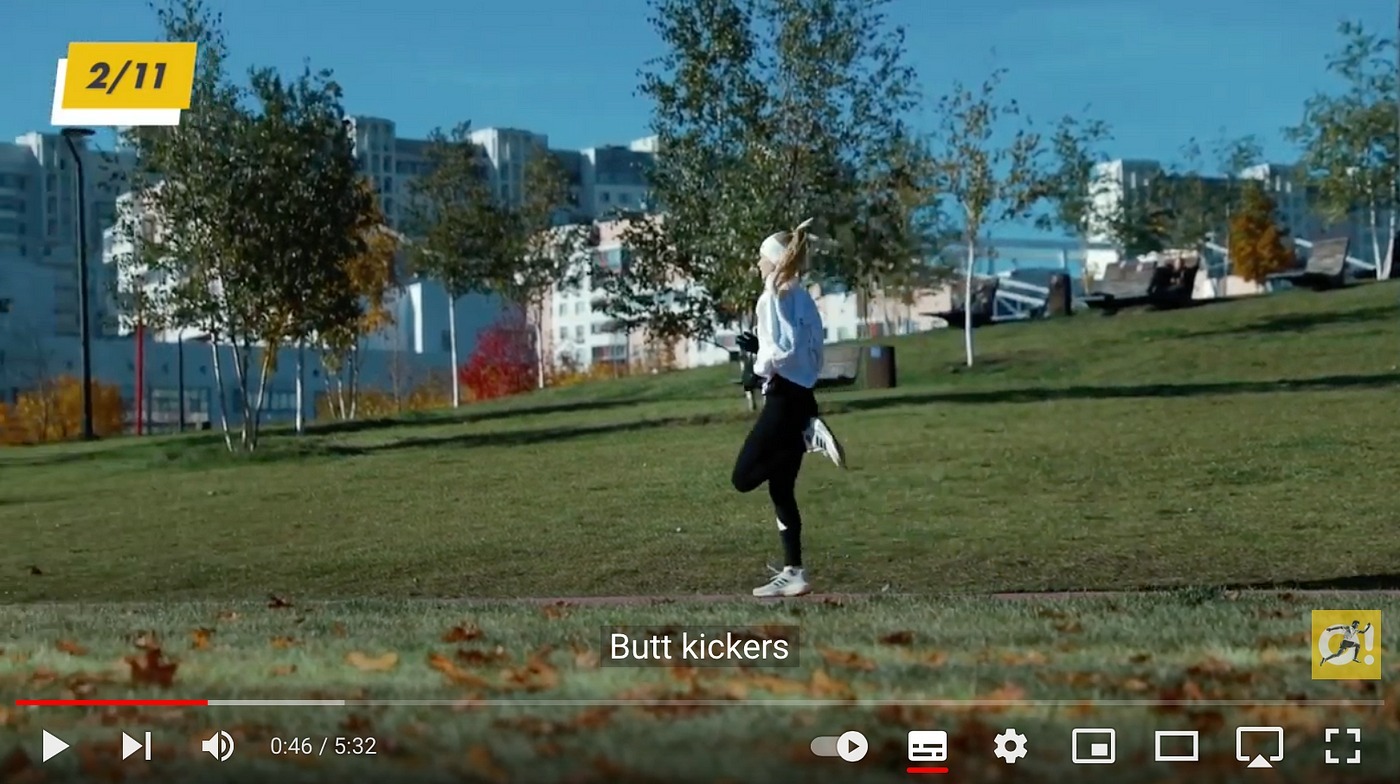In OMY! Sports training tasks you can often find a video of special running drills or ‘Running ABC’ as the first step. Their purpose is to warm up the muscles, ‘prepare’ the ligaments, and generate the necessary motor reflex to build it up during running.
You can probably recall some of them from the P.E. classes at school. They were a part of general physical training held in the beginning regardless of whether you were to play volleyball, train on the bar or run sprints during the class.
Each of the exercises is devoted to one particular (rotation) movement, one muscle, or one running gait cycle. Thus, their implementation in training involves a minimum of technical skill. It should be simple and almost intuitive: like watching the video and repeating the move.
Look them up on our Youtube Channel or other videos within your training plan. For your convenience, we have added subtitles to the videos and put the ‘Names’ of the drills on the screenshots as well. So you can quickly understand which description refers to what. Here we go!
Each of the exercises is devoted to one particular (rotation) movement, one muscle, or one running gait cycle. Thus, their implementation in training involves a minimum of technical skill. It should be simple and almost intuitive: like watching the video and repeating the move.
Look them up on our Youtube Channel or other videos within your training plan. For your convenience, we have added subtitles to the videos and put the ‘Names’ of the drills on the screenshots as well. So you can quickly understand which description refers to what. Here we go!
- High knees

Yes, this one represents an exaggerated form of running. With each foot push-off, the thigh rises to be in parallel with the surface. Hands move like normally in a run. Keep your body upright, do not lean back. The push-off is performed by the front part of the foot at a fast pace (cadence), as if you are on hot asphalt. The main movement is up, not forward; good knee lift and efficient strike. Though, it creates significant stress in the foot so it must be ‘ready’. To reduce injury, it is advisable to perform this exercise after 1-2 km of slow running or jogging.
2. But kickers

This drill is aimed at the upper legs and is performed so that with each overlap your heel (almost) touches the glutes. The foot, calf muscles and muscles of the back of the thigh – hip flexors – are getting activated. Do it at a relatively fast pace, the hands work like in a run.
3. Straight leg running.

Especially useful for additional strengthening of the foot. The main point here is that moving forward is made mainly by the foot. Therefore, it is important to land on an ‘elastic’, ready-to-push-off-foot and immediately bounce off, propelling yourself forward. The higher the straight leg in front of you rises, the stronger the momentum in the push off and hence the more iliopsoas muscle is involved.
4. Straight leg running asymmetrically.

This is an upgraded variation of the previous exercise. Only, in this case, one leg is alternately brought more forward than the other. So you can work more on the preferable side.
5. High knee skips.

An interesting exercise that perfectly activates the bottom part of the legs: your foot, ankle ligaments, and calf muscles. Pushing off as if in a light jump, you ‘charge up’ the foot and muscles for the work that lies ahead – during the run. It’s important not to put too much power in – just moderate pushing off the ground is enough for 20-30 reps per leg to wake up and prep the foot and ligaments.
6. High knee bouncing

“High knee” level up. This one works out the foot sensors and stability (rebounding repulsion of the foot) and also increases the length and speed of the step (through lifting up the hip). Still, it does not generate too much pressure on the foot due to frequent stepping. Almost a superpower pump-up!
7 – 8. Side leg

Moving on to coordination! It is like running sideways, in short: turn to the side - the leading on the selected side transfers the body forward, pushes off performing a slight jump and landing > and repetition. The lateral muscles work, the foot, calf and soleus muscles are being worked out. It is important to keep your heels high. Change sides: a set on the left side, then the right side (or vice versa).
9-10. Carioca

Helps to improve the range of motion of the hips and knee joints. It is performed with arms extended at both sides to keep the position of the body as stable as possible. It is performed on each side separately - the left side, then the right (or vice versa).
11. Strides

You know if you know 😊 To top off all the exercises performed earlier in one acceleration of 50–100 m. The ‘gold standard’ includes high hips, a wide step, body – straighten up, free work of the hands. Start from standing, speed up to a jog and then keep accelerating until you’re running at around 90% of your top power over the last 10 meters. Go, go, go!
To be continued.
Your OMY! Sports Team
